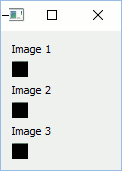I would recommend to do not multi-threading in GUI programming. Although, Qt provides multi-threading support in general, IMHO, the widgets are not well-prepared for this.
Thus, to achieve image loaders which run concurrently in separate threads I would suggest the following concept:
Each threaded image loader feeds a private buffer. The GUI inspects from time to time (using QTimer) these buffers and updates its QPixmap. As access to buffers should be possible from the resp. image loader thread as well as the GUI thread they have to be mutex guarded, of course.
My sample code testLoadImageMT.cc:
#include <atomic>
#include <chrono>
#include <mutex>
#include <thread>
#include <QtWidgets>
// manually added types (normally provided by glib)
typedef unsigned guint;
typedef unsigned char guint8;
// the fluffy-cat image sample
struct Image {
guint width;
guint height;
guint bytes_per_pixel; /* 3:RGB, 4:RGBA */
guint8 pixel_data[1];
};
extern "C" const Image fluffyCat;
class ImageLoader {
private:
const Image &_img;
std::atomic<bool> _exit;
std::mutex _lock;
QImage _qImg;
std::thread _thread;
public: // main thread API
ImageLoader(const Image &img = fluffyCat):
_img(img),
_qImg(img.width, img.height, QImage::Format_RGB888),
_exit(false), _thread(&ImageLoader::loadImage, std::ref(*this))
{ }
~ImageLoader()
{
_exit = true;
_thread.join();
}
ImageLoader(const ImageLoader&) = delete;
void applyImage(QLabel &qLblImg)
{
std::lock_guard<std::mutex> lock(_lock);
qLblImg.setPixmap(QPixmap::fromImage(_qImg));
}
private: // thread private
void loadImage()
{
for (;;) {
{ std::lock_guard<std::mutex> lock(_lock);
_qImg.fill(0);
}
size_t i = 0;
for (int y = 0; y < (int)_img.height; ++y) {
for (int x = 0; x < (int)_img.width; ++x) {
const quint32 value
= _img.pixel_data[i + 2]
| (_img.pixel_data[i + 1] << 8)
| (_img.pixel_data[i + 0] << 16)
| (0xff << 24);
i += _img.bytes_per_pixel;
{ std::lock_guard<std::mutex> lock(_lock);
_qImg.setPixel(x, y, value);
}
if (_exit) return; // important: make thread co-operative
}
std::this_thread::sleep_for(std::chrono::milliseconds(100)); // slow down CPU cooler
}
}
}
};
int main(int argc, char **argv)
{
// settings:
enum { N = 3 }; // number of images loaded/displayed
enum { Interval = 50 }; // update rate for GUI 50 ms -> 20 Hz (round about)
// build appl.
qDebug() << "Qt Version: " << QT_VERSION_STR;
QApplication app(argc, argv);
// build GUI
QWidget qMainWin;
QVBoxLayout qVBox;
QLabel *pQLblImgs[N];
for (int i = 0; i < N; ++i) {
qVBox.addWidget(
new QLabel(QString::fromUtf8("Image %1").arg(i + 1)));
qVBox.addWidget(
pQLblImgs[i] = new QLabel());
}
qMainWin.setLayout(&qVBox);
qMainWin.show();
// build image loaders
ImageLoader imgLoader[N];
// install timer
QTimer qTimer;
qTimer.setInterval(Interval); // ms
QObject::connect(&qTimer, &QTimer::timeout,
[&imgLoader, &pQLblImgs]() {
for (int i = 0; i < N; ++i) {
imgLoader[i].applyImage(*pQLblImgs[i]);
}
});
qTimer.start();
// exec. application
return app.exec();
}
Sorry, I used std::thread instead of boost::thread as I've no experience with the latter, nor a working installation. I believe (hope) the differences will be marginal. QThread would have been the "Qt native" alternative but again – no experiences.
To keep things simple, I just copied data out of a linked binary image (instead of loading one from file or from anywhere else). Hence, a second file has to be compiled and linked to make this an MCVE – fluffyCat.cc:
/* GIMP RGB C-Source image dump (fluffyCat.cc) */
// manually added types (normally provided by glib)
typedef unsigned guint;
typedef unsigned char guint8;
extern "C" const struct {
guint width;
guint height;
guint bytes_per_pixel; /* 3:RGB, 4:RGBA */
guint8 pixel_data[16 * 16 * 3 + 1];
} fluffyCat = {
16, 16, 3,
"x211s215232200gw`fx`at[cx^cw^fu\itZerWn|ap~cv204jnzedq^fr^kzfhv^Ra"
"GRbMWdR\jXer^qw_311256226271253235275264252315277260304255"
"231u~i213225207l{fly`jx\^nRlz_z206nlx`t~i221211s372276243375"
"336275376352340356312301235216212judgwcl~f212226u}206h212"
"224q231237z232236{216225v225230200306274244376360327376"
"361331376360341326275272253240244{203p202220xp~e{204^222"
"230n212217g240242{234236z214222r270271247360353340376370"
"336376363334375357336310254262232223234\gRfrX204220z212"
"225g225232j254255177252250{225226u304302265374365351376"
"375366376367341376361320374346324306241242237232235n{fj"
"xckyfu~fUX@VZCfnT231231207374374371377372354376376374376376"
"372376362332375340301341300264260253262jvdbq\XkVJTDNTCCG8O"
"TE322321313377377375376376373376377376376376375376374362"
"376360342344311306250244254R_PL^HXkT<@2OP@`dP217220177374374"
"370377377374376375371377377376376374360377367336376350"
"316342303274246236245jtbXdQTdNQYGU\KchV317315302377376372377"
"376367376373360377376367376366337376355312374331271323"
"263251216214214\hTP^HL\FR[LMXI^dW355352342376375366377374"
"360376374361376374361376356321374331264374330266330270"
"260200||Y`SLVE>K9BJ<CN?VYP347330322376366345376363330376367"
"337377372350374342314326243210375350314352317304shc^`TV`"
"RVbT>B4IS?PTD244232216374355320376354311376351306376362332"
"374344321267206u375362337326274272\POMNBT]LNZH:<*<A*TV>OI;242"
"222207340304243375335262372336272376361334320241212374"
"352322266233237c\WFH;MR>\`F~xP220214[pqE211202\g]=230214`313"
"266207344303240362336274323257201333304240305252204254"
"232p216206\206203U232224b234244b246257m220232`224227h~202"
"W206213]204210W227227i|177RvzNlsGrtJwtLz}N{204RlxF",
};
I compiled and tested in VS2013, with Qt 5.9.2 on Windows 10 (64 bit). This is how it looks:

